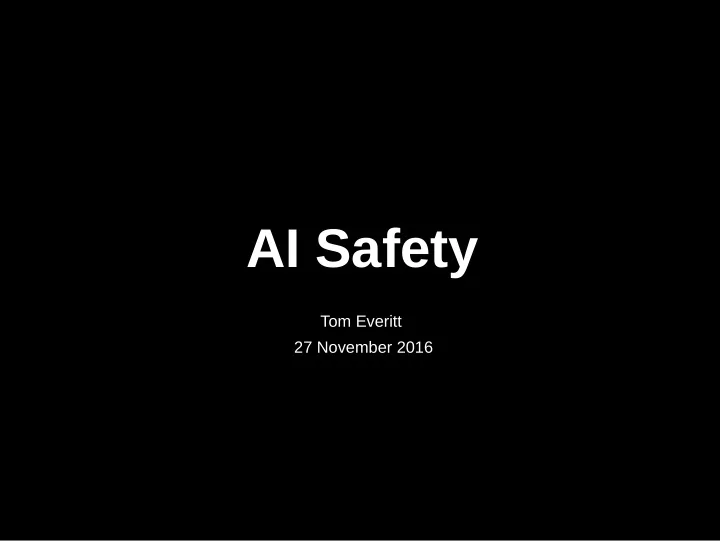

AI Safety Tom Everitt 27 November 2016
Assumed Background ● E x i s t e n t i a l r i s k s ● AI/ML progressing fast – E v i l g e n i e e f f e c t – Deep Learning, DQN – Distinction between: – Increasing investments: HLAI 10 years? SuperAI ● G o o d a t a c h i e v i n g soon after goals (intelligence) ● Having good goals – “Systemic” risks: (value alignment) ● Unemployment ● Autonomous warfare ● Surveillance capability ? civilisation human-level time now takeoff
Assumption 1 (Utility) ● The performance (or utility) of the agent is how well it optimises a true utility function ● is the time-t performance of agent ● Want agent to maximise http://www.gandgtech.com/utility_industry_technology.php
Assumption 2 (Learning) ● It is not possible to (programmatically) express the true utility function ● The agent has to learn u from sensory data ● Dewey (2011): Hopefully: http://users.eecs.northwestern.edu/~argall/learning.html
Assumption 3 (Ethical Authority) ● Humans are ethical authorities ● By definition? ● Human control = Safety?
Where can things go wrong?
Self-modification ● Will the agent want to change itself? ● Omohundro (2008): An AI will not want to change its goals, because if future versions of the AI want the same goal, then the goal is more likely to be achieved ● As humans, utility function is part of our identity: Would you self-modify into someone content just watching TV?
Self-Modification ● Everitt et al. (2016): Formalising Omohundro’s argument ● Three types of agents Hedonistic Ignorant Realistic Wants to self-modify Doesn’t understand the difference Resists (self)-modification
Corrigibility/Interruptability ● What if we want to modify or shut down agent? ● Opposes self-preservation drive? ● Depends reward range for AIXI-like agents ( M a r t i n e t a l . , 2 0 1 6 ) r = -1 r = 0 r = 1 Death
Functionality vs. Corrigibility ● Either being on or being off will have higher utility ● Why let the human decide?
Cooperative Inverse Reinforcement Learning (Hadfield-Menell et al, 2016) ● Optimal action for agent is to let human decide, assuming: – Agent sufficiently uncertain about u, and Doesn’t know u Knows u Possibly irrational – Agent believes human is sufficiently rational ● See also Safely Interruptible Agents (fiddles with details in the learning process) (Orseau & Armstrong, 2016)
Evidence Manipulation ● Aka Wireheading, Delusionbox http://www.cinemablend.com/new/Wachowskis-Planning-Matrix-Trilogy-41905.html ● Ring and Orseau (2011): – Intelligent, real-world, reward maximising (RL) agent will wirehead – Knowledge-seeking agent will not wirehead
Value Reinforcement Learning ● Everitt and Hutter (2016) ● Instead of optimising r, optimise with reward as evidence about true utility function ● ‘Too-good-to-be-true’ condition removes incentive to wirehead ● Current project: – Learn what a delusion is – No ‘too-good-to-be-true’ condition – Avoid wireheading by accident
Supervisor Manipulation ● What about putting the human in a delusion box? (Matrix trilogy) ● No serious work yet ● Hedonistic utilitarians need not worry
(Imperfect) Learning ● Ideal learning: – Bayes theorem, conditional probability – AIXI/Solomonoff induction http://childpsychologistindia.blogspot.com.au/2013/10/difference-between ● In practice: Model-free MIRI’s Logical inductor (2016) learning more efficient ● General model of belief states for deductively limited reasoners ● Good properties – Q-learning – Converges to probability – Sarsa – Outpaces deduction ● Current project: Model-free – Self-trust AIXI/General RL – Scientific induction
Decision Making ● Open source Prisoner’s Dilemma Barasz et al. (2014), Critch (2016) ● Refinements of Expected Utility Maximisation: – Causal DT – Evidential DT – Updateless DT – Timeless DT ● Logical inductors possibly useful (current MIRI research)
Biased Learning ● Cake or Death? – – Options: ● Kill 3 people ● Bake 1 cake ● Ask (for free) what’s the right thing to do – u(ask, bake cake) = 1 – u(kill) = 1.5 ● Motivated value selection (Armstrong, 2015) Interactive inverse RL (Armstrong and Leike, 2016) ● For properly Bayesian agents, no problem:
Assumptions: ● True utility function ● Learning ● Human ethical authority Cake-or-death Delusionbox, Value RL Self-preservation Open question Model-free AIXI, logical inductors, Cooperative IRL, decision suicidal agents, theories safely interruptible agents
References ● Armstrong (2015) Motivated Value Selection. AAAI Workshop ● Armstrong and Leike (2016) Interactive Inverse Reinforcement Learning. NIPS workshop ● Barasz, Christiano, Fallenstein, Herreshoff, LaVictoire, Yudkowsky (2014) Robust Cooperation in the Prisoner's Dilemma: Program Equilibrium via Provability Logic. Arxiv ● Critch (2016) Parametric Bounded Löb's Theorem and Robust Cooperation of Bounded Agents. Arxiv ● Dewey (2011) Learning what to value. AGI ● Everitt, Filan, Daswani, and Hutter (2016) Self-modification of policy and utility function in rational agents, AGI. ● Everitt and Hutter (2016) Avoiding Wireheading with Value Reinforcement Learning. AGI ● Garrabrant, Benson-Tilsen, Critch, Soares, Taylor (2016) Logical Induction. Arxiv ● Martin, Everitt, and Hutter (2016) Death and Suicide in Universal Artificial Intelligence, AGI ● Omohundro (2008) The Basic AI Drives, AGI ● Hadfield-Menell, Dragan, Abbeel, Russell (2016) Cooperative Inverse Reinforcement Learning. Arxiv ● Orseau and Armstrong (2016) Safely interruptible agents. UAI ● Ring and Orseau (2011) Delusion, Survival, and Intelligent Agents. AGI
Recommend
More recommend